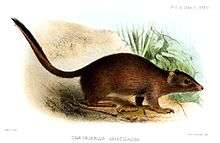Mulgara
| Mulgaras[1] | |
|---|---|
 | |
| Crest-tailed mulgara (Dasycercus cristicauda) | |
| Scientific classification | |
| Kingdom: | Animalia |
| Phylum: | Chordata |
| Class: | Mammalia |
| Infraclass: | Marsupialia |
| Order: | Dasyuromorphia |
| Family: | Dasyuridae |
| Subfamily: | Dasyurinae |
| Tribe: | Dasyurini |
| Genus: | Dasycercus Peters, 1875 |
| Type species | |
| 'Chaetocercus' cristicauda Krefft, 1867 | |
| Species | |
Mulgaras are the two species in the genus Dasycercus.[2] They are marsupial carnivores, closely related to the Tasmanian devil and the quolls, that live in deserts and spinifex bush of central Australia, but are extinct in New South Wales.[3] They are 12.5–22 cm long with a 7– to 13-cm tail. They are nocturnal, but occasionally "sunbathe" in the entrance of the burrow in which they dwell. Their kidneys are highly developed to excrete extremely concentrated urine to preserve water, as the animals rarely drink. They feed mostly on insects, but also eat lizards and young snakes. They breed from June–September and have litters of six or seven young. The pouch comprises two lateral folds of skin.
The genus once contained other species, but they were moved to other genera, leaving only D. cristicauda. Recent research has shown two distinct species, which are very similar. The brush-tailed mulgara (D. blythi), synonymous with D. hilleri, has an uncrested tail, two upper premolars, and six nipples. The crest-tailed mulgara (D. cristicauda) has a crested tail, three upper premolars, and eight nipples.[4]
The generic name Dasycercus means "hairy tail".[5]
Species identification
A long history of confusion exists when classifying mulgaras, and only recently has confidence in identifying the two species been gained. Identification of the species has been greatly assisted by detailed genetic and morphological studies of museum specimens. The most distinguishing feature in identifying the two species is the crest of hair on the tail. The crest-tailed mulgara has a crest of long black hairs on the upper side of the distal end of the tail, while the brush-tailed mulgara has a brush of black hairs along the final two-thirds of the tail. The two species also have a slightly different dental formation, which is difficult to observe in live animals, and the brush-tailed mulgara has six nipples while the crest-tailed Mulgara has eight. Mulgaras are distributed through the arid regions of Western Australia where they live in short burrows. The crest-tailed mulgara is listed as vulnerable.[6]
See also
References
- ↑ Groves, C.P. (2005). Wilson, D.E.; Reeder, D.M., eds. Mammal Species of the World: A Taxonomic and Geographic Reference (3rd ed.). Baltimore: Johns Hopkins University Press. p. 24. ISBN 0-801-88221-4. OCLC 62265494.
- ↑ Chris Pavey; Jeff Cole; John Woinarski (2005). "THREATENED SPECIES OF THE NORTHERN TERRITORY BRUSH-TAILED MULGARA" (PDF). Parks and Wildlife Commission, Northern Territory.
- ↑ Ellis, M. (1992). The Mulgara, Dasycercus cristicauda (Krefft, 1867): a new dasyurid record for New South Wales. Australian Zoologist. 28:57-58.
- ↑ Woolley, P.A. (2005). "The species of Dasycercus Peters, 1875 (Marsupialia: Dasyuridae)" (PDF). Memoirs of Museum Victoria. 62 (2): 213–221.
- ↑ Woolley, P.A. (1995). "Mulgara". In Ronald Strahan. The Mammals of Australia. Reed Books. pp. 55–56.
- ↑ http://museum.wa.gov.au/research/collections/mammals/mammalogy-mammals-collection/mulgaras